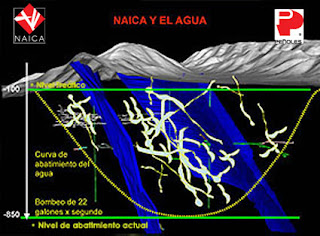 |
The region of Chihuahua, Mexico has a diverse geography. Known for it's desert for namesake, it has more forests than any other Mexiacan state. The southern point of the Rock Mountains reach this region as well, making it a mineral rich area for mining. Subtropical lowlands and highlands exist to the south west. It has a varied flora and fauna due to this unique geography as well. The cave's of Naica mines are still somewhat of an enigma but are certainly attributed to the coastal waters and weather patterns it has been effected to for many years. In this posting I will describe and discuss what I think this region will become 1,000, 10,000 and 1,000,000 years into the future.
- 1,000 years from today ~ I surmise that by 3012 this region will have gone through a mild change in terrain. The forest will have dried up and fire will have engulfed half of it's trees. A cualdren of pressurized, molten rock that the cave borders is jarred loose creating thermal expansion and a pocket of the cave to be filled in and cooled. The gypsum crystalization is halted throughout the rest of the cave as the unique water chemistry is no longer present. The limestone rock still expands and contracts with the heating and cooling prosesses. Weathering of some of the shallower caves are effected by new root growth of the newer trees above. Creating some cracking and evaporation of some humidity and moisture.
- 10,000 years from today ~ There is a meteor that hits the Earth in the south pacific. Creating a world wide catastrophy. Massive tsunamis and earthquakes occur on numerous continents. Mexico gets 40 foot surges that pummel the shoreline wiping out all surrounding coastlines. 50 years afterwards the Conchos River, the largest river in Chihuahua, begins to form again after being flooded completely. We find numerous different channels that become braided and meandering back to the shore. The flow has changed from what it was in the past due to the devestated terrain form the mass flooding. The cave is virtually buried at this point from sediment and volcanic activity.


It's hard to extrapolate completely on how the earth will change over the next 1,000,000 years. There are so many variables that must be taken into consideredation. Weathering, erosion, volcanic activity, flooding, cracking, drying and moisturizing are all factors to consider outside of the devestational. The Earth is brilliant organism that is resiliant and every changing. Looking at it from an objective and outside view puts things into perspective. Knowing it's past really helps us to gauge it's future.
- 1,000,000 years from today ~ After 1 million years passes we find the Earth in a very differnt condition. A global warming has occured over the last 50,000 years. Water levels rise to 150 feet above the formal sea level. Many low lying continents have been fully submerged. But, since a pole shift has occured, the Earth has lost most of it's atmosphere and a drastic mass cooling of the planet is in place. The next ice age is beginning. The land mass known as Mexico is now in the Northern hemisphere. Under 1,000 feet of ice.




